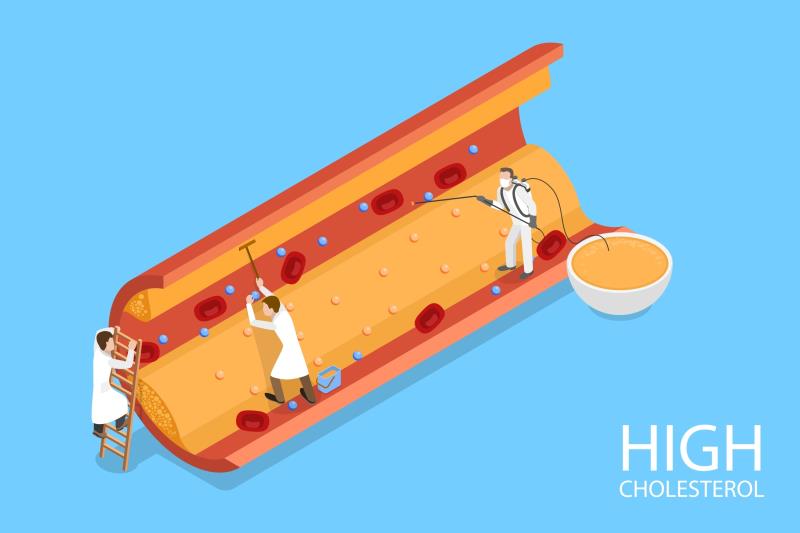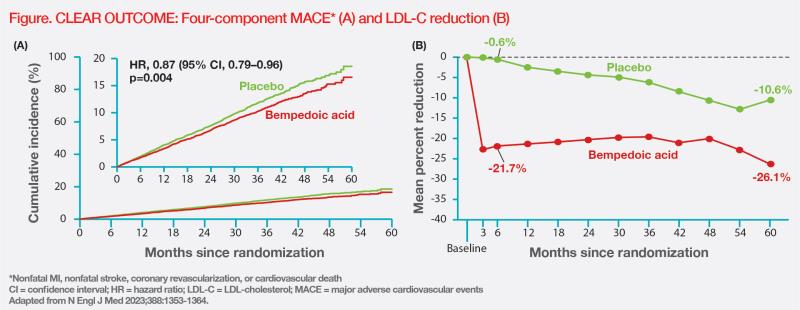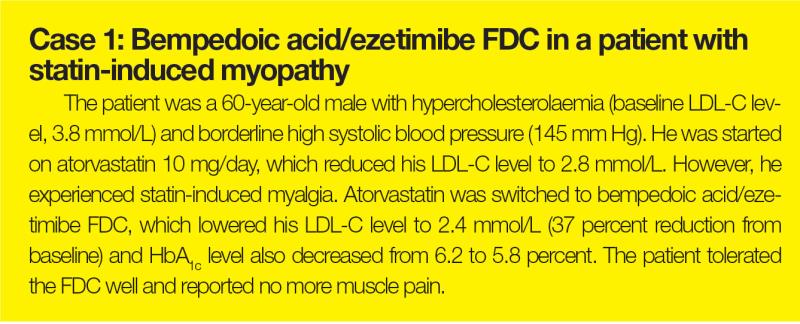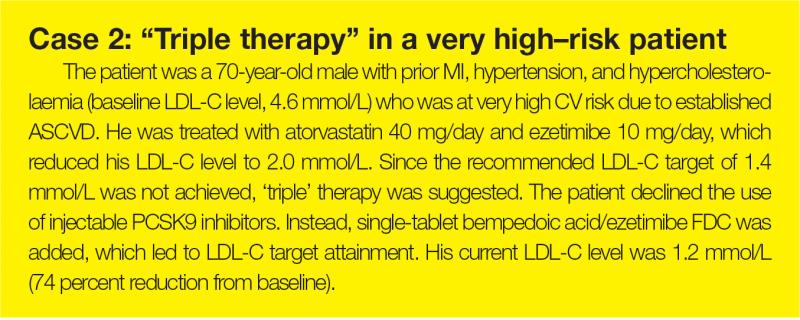Clinical role of oral bempedoic acid in LDL-C management





LDL-cholesterol (LDL-C) reduction is the key to preventing and treating atherosclerotic cardiovascular disease (ASCVD). Recent guidelines advocate aggressive LDL-C lowering in individuals at high or very high cardiovascular (CV) risk. At the Advances in Medicine 2024 conference, Dr Chu-Pak Lau, Specialist in Cardiology, discussed the clinical role of non-statin lipid-lowering therapies (LLTs), including oral bempedoic acid as a single agent or in fixed-dose combination (FDC) with ezetimibe, in patients who have failed to achieve guideline-recommended LDL-C targets or have statin intolerance.
Aiming for guideline recommended targets
Latest guidelines from both the European Society of Cardiology (ESC) and American College of Cardiology (ACC) recommend LDL-C reduction of ≥50 percent from baseline level and LDL-C targets in patients at very high (<1.4 mmol/L) or high CV risk (<1.8 mmol/L). [Eur Heart J 2021;42:3227- 3337; J Am Coll Cardiol 2022;80:1366-1418]
Statin intolerance: Not a myth
While statins are the cornerstone of LLTs, up to 30 percent of patients may experience suspected statin intolerance. Amongst patients with recent MI, 47.2 percent reported not adhering well to statins. Notably, statin intolerance increased the risk of recurrent MI by 50 percent. In Hong Kong, statin intolerance occurred in 14.5 percent of patients and increased CV events if their highsensitivity C-reactive protein (hsCRP) level was also high. A systematic review and meta- analysis of 62 randomized controlled trials (n=120,456) revealed that statin-associated adverse events (AEs) of muscle symptoms, renal insufficiency, and liver dysfunction occurred in 9.6, 3.5, and 1.2 percent of patients, respectively, and a trend of increased diabetes risk was found. [J Clin Med 2023;12:2444; J Am Coll Cardiol 2017;69:1386-1395; BMJ 2021;374:n1537; BMC Cardiovasc Disorders 2019;19: 168; Canadian J Cardiol 2016;32:S35-S65]
“These AEs may further limit the use of statins, preventing patients from reaching guideline-recommended targets and, ultimately, increasing risk of CVD and mortality,” added Lau. “A variety of non-statin therapeutic agents are now in our toolbox for LDL-C target achievement.”
CLEAR Outcomes trial: Bempedoic acid ± ezetimibe
“Clearly, there is a need for non-statin therapy for LDL-C lowering independently or in conjunction with statins,” noted Lau. “[For example,] injectable LLTs targeting the proprotein convertase subtilisin/kexin type 9 [PCSK9] pathway offer a viable alternative.”
Bempedoic acid is a non-statin, oral, first-in-class ATP citrate lyase (ACL) inhibitor, which works upstream of HMG-CoA reductase (target enzyme of statins) in the cholesterol synthesis pathway. [J Clin Med 2023;12:3463]
The double-blind, randomized, placebo-controlled phase III CLEAR Outcomes trial evaluated the effect of bempedoic acid in 13,970 statin-intolerant patients (ie, unable or unwilling to take guideline-recommended doses of statins owing to unacceptable AEs) with a previous CV event (secondary prevention) or clinical features that placed them at high risk for a CV event (primary prevention). Use of ezetimibe with very-low-dose statins was allowed. [N Engl J Med 2023;388:1353-1364]
Mean LDL-C levels (-21.7 vs -0.6 percent) at 6 months and median hsCRP levels (-20.6 vs 0.0 percent) at 12 months were reduced with bempedoic acid vs placebo, confirming its LDL-C–lowering and antiinflammatory properties. (Figure)

Bempedoic acid significantly reduced the risk of the primary endpoint of four-component major adverse CV events (MACE) vs placebo. (Figure) Notably, in the subgroup of primary prevention patients, the risk reduction of four-component MACE vs placebo was consistent with the trial’s overall population. [JAMA 2023;330:131-140]

High- or very-high-risk patients not achieving target
“Doubling the dose of statins reduces LDL-C by about 7 percent, so we will quickly reach a ceiling effect,” noted Lau. “Therefore, early use of combination therapy should be considered in patients at high or very high CV risk not achieving the treatment target, as demonstrated in case 2.”

053 trial: Bempedoic acid/ ezetimibe FDC + statin
The phase III 053 trial was conducted to investigate the efficacy of bempedoic acid/ezetimibe FDC in 301 patients with hypercholesterolaemia at high CV risk on maximally tolerated statin therapy. At week 12, the FDC group had significantly lower LDL-C (placebo-corrected difference, -38.0 percent; p<0.001) and hsCRP (placebo- corrected difference, -46.1 percent; p<0.001) levels vs placebo. [Eur J Prev Cardiol 2020;27:593-603]
Potential side effects
As a prodrug metabolized in the liver, the incidence of myalgia was numerically lower with bempedoic acid vs placebo (5.6 vs 6.8 percent). Incidence rates of gout and gallstones were slightly higher with bempedoic acid vs placebo (3.1 vs 2.1 percent and 2.2 vs 1.2 percent, respectively), as were minor increases in serum creatinine, uric acid, and hepatic enzyme levels. [N Engl J Med 2023;388:1353-1364]
Positioning of oral LLTs
Both ezetimibe and bempedoic acid are oral non-statin LLTs. Ezetimibe is highly effective in combination with a statin for lowering LDL-C and reducing ASCVD risk. However, its efficacy in primary prevention and effects as monotherapy are less clear,” noted Lau. CLEAR Outcomes demonstrated CV benefits of bempedoic acid monotherapy in a broad population of patients requiring either primary or secondary prevention. Bempedoic acid is a valuable option for treatment of hypercholesterolaemia, either alone or in FDC with ezetimibe, particularly for statin-intolerant patients and those not achieving LDL-C targets. [N Engl J Med 2023;388:1353-1364; JAMA 2023;330:131-140; Cochrane Database Syst Rev 2018;11:CD012502]